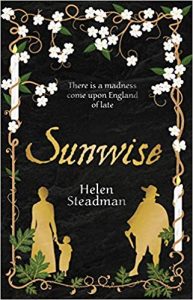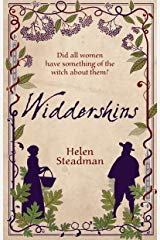Witchcraft And Writing: Using Method Writing To Create Authentic Historical Characters
Sunwise is the sequel to Widdershins, which was inspired by the witch trials that took place in Newcastle-upon-Tyne, England in 1650. Sixteen people were hanged on a single day on charges of witchcraft. Despite being the biggest execution of witches on a single day in England, the trials are not very well known about, so I wanted to bring this piece of history to life. (You don’t have to read Widdershins first, but it’s probably helpful if you want to fully understand this bit of hidden history.)
I decided to write a historical novel after reading Hilary Mantel’s magnificent Wolf Hall. Really, I had no clue what I was letting myself in for, and if I’d realised at the outset just how many years of research lay ahead of me, I’d probably never have started.
As well as learning everything about how people lived, thought and ate in the 17th century, I had to learn about witches, witchcraft, witch trials, witchfinders, herbal medicine, folklore, superstition, pagan and rural customs, farming, midwifery, methods of execution and torture, criminal psychology, civil war, religion and law in England and Scotland, and… sailing!
This meant reading a huge number of books, researching online and visiting archives, which involved getting to grips with tiny writing and 17th century English.
Perhaps the most interesting elements of the research were getting into character for the two main characters: Jane Chandler and John Sharpe. For Jane, whose life revolved around herbal healing, I decided to try out method writing. I signed up for some training at Dilston Physic Garden, where I spent many happy hours learning about tree medicine.
In the spirit of ‘first do no harm’, this involved learning to identify trees and plants – perhaps the single most important element of herbalism. I then harvested bark, leaves, berries and acorns before turning them into various remedies.
My training provided a decent working knowledge of how to make an anti-inflammatory painkilling powder from willow and an acorn decoction that can be used for mouthwash, antiseptic and a useful aftershave to stop bleeding. I also put a bottle of vodka to very good use with some hawthorn berries to make a hawthorn tincture, which is good for heart ailments and broken hearts alike.
Best of all, I learnt how to make elderberry linctus. The herbalist showed how elder sprigs resemble the inside of lungs, meaning it’s very good for strengthening the lungs. As someone who suffers from terrible chest infections, I was pleased to make this delicious medicine (and not just because it goes nicely with gin).
As well as the medicinal properties of plants, Dilston also teaches about their folkloric elements, making it something of a psychic garden too. Elder really resonated with me, and anyone reading Widdershins will feel the influence of the so-called ‘witch tree’ throughout. After my training, I started growing herbs at home in my magic tea garden. This helped me learn about sowing, growing, harvesting and drying cycles so I could then make my own remedies. I also continued to forage in the wild, which helped me to get into Jane’s character.
For Sunwise, I continued my practical research. In the chapter, ‘Harvest Moon’, Jane has to make the corn dolly for the kern supper to celebrate the safe bringing in of the harvest and to ensure fertility for the coming year. A farmer friend kindly gave me a sheaf of barley so I could practise making corn dollies to get the details correct.
Once I’d got the hang of it, I made a few dozen corn dollies to send out with the review copies of Sunwise. These were heart-shaped Countryman’s Favours, which would traditionally be offered to find out whether love was requited or not. Something of the witch must have rubbed off on me while I was making the corn dollies as one of the book reviewers has since told me her Countryman’s Favour ended a dry spell for her and she’s now found love!
When it came to researching John Sharpe, I took a different tack – there was simply no way I was going to inflict pain and humiliation on myself or anyone else. What I did was to read as many witchfinder accounts as I could – so depositions from the likes of John Kincaid in Scotland, and also the books published by Matthew Hopkins, the self-styled Witchfinder General and his sidekick, John Stearne.
It was important to read these accounts critically, however, and in conjunction with other documents. For example, Hopkins claimed that he wasn’t in witchfinding for the money and charged very little, but the fact that Ipswich raised taxes to pay its witchfinding bills calls his claim into question.
These accounts were very useful for understanding the practices of witch prickers, but their psychology was more difficult. From a witness deposition about the Newcastle witch trials, I considered the witchfinder to be a sexual sadist, given the way he stripped his victims and bent them over in a public place before pricking them. This led me to research theories about sexual sadists, which made for very grim reading and I have to say, I much preferred carrying out the herbal research.
If you read Widdershins and Sunwise, the foraging, harvesting and preparations carried out by Jane and Annie Chandler, Meg Wetherby, Dora Shaw and Kirsty Slater were all done by me, so I hope my hard work has paid off in making the work of the cunning women both detailed and authentic. I’m still testing method writing and for my next novel, which is about a 17th century swordmaker, I’ve trained in blacksmithing and have made my own sword!
About the author
Helen Steadman lives in the foothills of the North Pennines, and she loves researching and writing about the history of the north east of England. Following her MA in creative writing at Manchester Metropolitan University, she’s currently completing a PhD in English at the University of Aberdeen in Scotland. Now that her tales of the 1650 Newcastle witch trials are complete, she’s just finished drafting a novel about the Shotley Bridge swordmakers, The Running Wolf, which is due to be published by Impress Books later in 2020. Helen is now resuming work on a novel about Grace Darling, the famous Northumberland lighthouse-keeper’s daughter.
Find out more:
Website: https://helensteadman.com/
Twitter: @hsteadman1650
Instagram: @helensteadman1650
Facebook: https://www.facebook.com/helensteadmanauthor/
Sunwise
 ‘There is a madness come upon England of late.’
‘There is a madness come upon England of late.’
Sunwise is a sequel and it picks up where Widdershins left off in August 1650. When Jane’s lover, Tom, returns from the navy to find her unhappily married to his betrayer, Jane is caught in an impossible situation. Still reeling from the loss of her mother at the hands of the witch-finder John Sharpe, Jane has no choice but to continue her dangerous work as a healer while keeping her young daughter safe. But, as Tom searches for a way for him and Jane to be together, the witch-finder is still at large. Filled with vengeance, John will stop at nothing in his quest to rid England of the scourge of witchcraft. Inspired by true events, Sunwise tells the story of one woman’s struggle for survival in a hostile and superstitious world.
Buy Link: Book Depository (free international shipping)
 ‘Did all women have something of the witch about them?’
‘Did all women have something of the witch about them?’
Jane Chandler is an apprentice healer. From childhood, she and her mother have used herbs to cure the sick. But Jane will soon learn that her sheltered life in a small village is not safe from the troubles of the wider world.
From his father’s beatings to his uncle’s raging sermons, John Sharpe is beset by bad fortune. Fighting through personal tragedy, he finds his purpose: to become a witch-finder and save innocents from the scourge of witchcraft.
Inspired by true events, Widdershins tells the story of the women who were persecuted and the men who condemned them.
Category: Contemporary Women Writers, How To and Tips
























